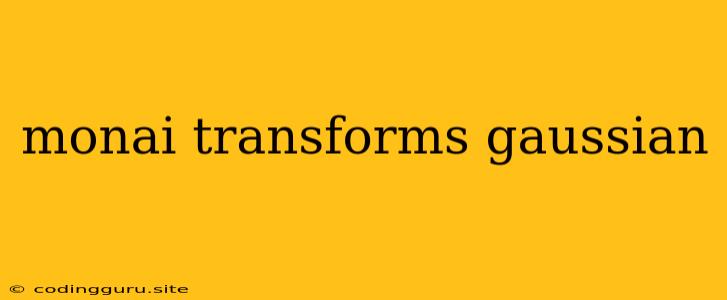Understanding and Utilizing MONAI Transforms for Gaussian Noise
Medical image analysis is often hampered by the presence of noise, which can obscure important features and hinder accurate diagnoses. Gaussian noise, a common type of noise in medical images, is characterized by its random distribution with a mean of zero and a standard deviation that determines its intensity. To effectively analyze medical images, it's crucial to pre-process them to remove or mitigate this noise.
MONAI, an open-source framework for medical imaging AI, provides a comprehensive suite of transforms that can be applied to medical images to improve their quality and prepare them for analysis. Gaussian transforms are a key component of MONAI's noise reduction toolkit. These transforms are designed to effectively remove or reduce Gaussian noise from medical images.
Why are Gaussian Transforms Important?
Gaussian noise can arise from various sources, including limitations in image acquisition devices, transmission channels, and even the underlying biological processes being captured. Here's why addressing it is crucial:
- Improved Visual Clarity: Gaussian noise can obscure fine details and make it difficult to interpret the image. Removing it enhances visual clarity and makes it easier for human observers and algorithms to identify relevant features.
- Enhanced Feature Extraction: Noise can interfere with the effectiveness of feature extraction algorithms used in machine learning models. Reducing noise can lead to more accurate and robust feature representations.
- Improved Model Performance: Machine learning models trained on noisy images may exhibit reduced accuracy and generalization capabilities. Pre-processing to remove Gaussian noise can significantly improve model performance.
MONAI's Gaussian Transforms: A Powerful Toolkit
MONAI offers a range of transforms specifically designed to handle Gaussian noise, allowing you to tailor the approach to your specific needs. Let's explore some of the key transforms and their applications:
1. Gaussian Noise:
- Functionality: This transform directly adds Gaussian noise to an image. It's useful for simulating noisy conditions or testing the robustness of your models to noise.
- Example: You can use this transform to generate synthetic noisy images for training your machine learning model, making it more resilient to real-world noise.
2. Random Gaussian Noise:
- Functionality: Similar to the standard
GaussianNoisetransform, but allows for more flexible control over the noise characteristics, including the mean and standard deviation. - Example: You can utilize this transform to generate noise with specific properties, such as higher or lower standard deviations, to simulate different noise levels.
3. Gaussian Blur:
- Functionality: This transform applies a Gaussian filter to the image, effectively smoothing out noise and reducing sharp edges.
- Example: Applying Gaussian blur can be helpful for reducing speckle noise in ultrasound images, enhancing the overall image quality.
4. Gaussian Sharpen:
- Functionality: The opposite of Gaussian blur, this transform enhances sharp edges and potentially exaggerates noise.
- Example: While not typically used for noise reduction, this transform can be employed to highlight specific features in an image, particularly for segmentation tasks.
Implementing Gaussian Transforms in MONAI
Using MONAI's Gaussian transforms is straightforward. Here's a simplified example demonstrating the application of Gaussian blur:
import monai
import numpy as np
# Load your image (replace with your image data)
image = np.random.rand(128, 128)
# Define the Gaussian blur transform
gaussian_blur = monai.transforms.GaussianSmooth(kernel_size=5)
# Apply the transform
smoothed_image = gaussian_blur(image)
# Visualize the results (replace with your preferred visualization method)
# ...
Choosing the Right Transform
Selecting the appropriate Gaussian transform for your application depends on several factors, including the type of noise present, the desired level of smoothing, and the specific task at hand. Consider these factors when choosing:
- Noise Characteristics: The intensity and spatial distribution of the noise will influence the best approach.
- Image Type: The nature of the image (e.g., MRI, CT, ultrasound) may require specific noise reduction techniques.
- Task Objectives: The goals of your analysis, such as segmentation, classification, or registration, will affect the choice of transform.
Best Practices for Gaussian Noise Reduction
- Experimentation: Try different transforms and their parameters to find the optimal settings for your data.
- Combine Transforms: For complex noise scenarios, combining multiple transforms, such as Gaussian blur with median filtering, may be beneficial.
- Visual Assessment: Always visually inspect the results to ensure that the transforms are effectively reducing noise without introducing unwanted artifacts.
- Quantitative Evaluation: Use objective metrics, such as the signal-to-noise ratio (SNR), to quantify the effectiveness of the noise reduction process.
Conclusion
Gaussian noise is a common challenge in medical image analysis. MONAI's Gaussian transforms provide a powerful toolkit for mitigating this noise, enabling improved image quality and ultimately leading to more accurate and robust diagnoses. By carefully selecting the appropriate transforms and implementing them effectively, you can unlock the full potential of your medical images. Remember to experiment, evaluate, and refine your approach based on the specific characteristics of your data and your analysis goals.
